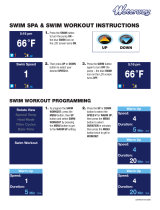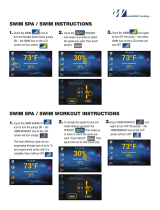
Table of Contents
Introduction.....................................................................1
Device Overview......................................................................... 1
GPS Status and Status Icons..................................................... 1
Pairing Your Smartphone with Your Device............................... 1
Training........................................................................... 1
Going for a Pool Swim................................................................ 1
Auto Rest............................................................................... 1
Distance Recording................................................................2
Training with the Drill Log...................................................... 2
Setting a Swim Pace Alert..................................................... 2
Editing a Pace Alert During Pool Swimming.......................... 2
Workouts.....................................................................................2
Following a Pool Swim Workout............................................ 2
Recording a Critical Swim Speed Test.................................. 2
Editing Your Critical Swim Speed Result............................... 3
About the Training Calendar.................................................. 3
Personal Swim Records............................................................. 3
Viewing Your Personal Records............................................ 3
Restoring a Personal Record................................................. 3
Clearing a Personal Record................................................... 3
Clearing All Personal Records............................................... 3
Swimming in Open Water........................................................... 3
Swim Information........................................................................ 3
Swim Terminology................................................................. 3
Stroke Types.......................................................................... 3
Starting an Activity...................................................................... 3
Tips for Recording Activities.................................................. 4
Stopping an Activity.................................................................... 4
Training Indoors.......................................................................... 4
Activity Tracking............................................................ 4
Auto Goal.................................................................................... 4
Using the Move Alert.................................................................. 4
Turning on the Move Alert......................................................4
Intensity Minutes......................................................................... 4
Earning Intensity Minutes.......................................................4
Sleep Tracking............................................................................ 4
Using Automated Sleep Tracking.......................................... 4
Using Do Not Disturb Mode................................................... 4
Smart Features............................................................... 4
Bluetooth Connected Features................................................... 4
Manually Syncing Data with Garmin Connect........................5
Widgets....................................................................................... 5
Viewing the Widgets.............................................................. 5
Viewing the Controls Menu......................................................... 5
Locating a Lost Mobile Device.................................................... 5
Controlling Music Playback on a Connected Smartphone......... 5
Enabling Bluetooth Notifications................................................. 6
Viewing Notifications.............................................................. 6
Managing Notifications...........................................................6
Turning Off the Bluetooth Smartphone Connection............... 6
Turning On and Off Smartphone Connection Alerts.............. 6
Syncing Activities........................................................................ 6
Heart Rate Features....................................................... 6
Wrist-based Heart Rate.............................................................. 6
Heart Rate While Swimming.................................................. 6
Wearing the Device................................................................6
Tips for Erratic Heart Rate Data.............................................6
Viewing the Heart Rate Widget.............................................. 6
Broadcasting Heart Rate Data to Garmin Devices................ 7
Setting an Abnormal Heart Rate Alert....................................7
Turning Off the Wrist-based Heart Rate Monitor................... 7
About Heart Rate Zones............................................................. 7
Fitness Goals......................................................................... 7
Setting Your Maximum Heart Rate
........................................ 7
Customizing Your Heart Rate Zones and Maximum Heart
Rate....................................................................................... 7
Heart Rate Zone Calculations................................................ 7
Training Effect.............................................................................8
Heart Rate Variability and Stress Level...................................... 8
Using the Stress Level Widget............................................... 8
Body Battery............................................................................... 8
Viewing the Body Battery Widget...........................................8
Tips for Improved Body Battery Data..................................... 9
History............................................................................. 9
Swim History............................................................................... 9
Viewing History........................................................................... 9
Deleting History.......................................................................... 9
Viewing Data Totals.................................................................... 9
Data Management...................................................................... 9
Deleting Files......................................................................... 9
Disconnecting the USB Cable................................................9
Garmin Connect..........................................................................9
Syncing Your Data with the Garmin Connect App................. 9
Using Garmin Connect on Your Computer............................ 9
Customizing Your Device............................................ 10
Setting Up Your User Profile.....................................................10
Activity Options......................................................................... 10
Customizing Your Swim Options......................................... 10
Customizing Your Activity Options....................................... 10
Changing Your Displayed Activities..................................... 10
Setting a Recurring Alert...................................................... 10
Setting the Pool Size............................................................10
Setting a Countdown Start................................................... 10
Customizing the Data Fields................................................ 10
Turning on the Lap Key....................................................... 10
Marking Laps by Distance....................................................11
Using the Auto Pause® Feature.......................................... 11
Changing the GPS Setting................................................... 11
Customizing the Widget Loop................................................... 11
Activity Tracking Settings..........................................................11
Turning Off Activity Tracking................................................ 11
Watch Face Settings.................................................................11
Customizing the Watch Face............................................... 11
Downloading Connect IQ Features...................................... 11
Downloading Connect IQ Features Using Your Computer.. 11
System Settings........................................................................ 11
Time Settings....................................................................... 12
Time Zones.......................................................................... 12
Changing the Backlight Settings.......................................... 12
Setting the Device Sounds.................................................. 12
Locking and Unlocking the Device....................................... 12
Displaying Pace or Speed....................................................12
Changing the Units of Measure........................................... 12
Clock......................................................................................... 12
Setting the Time Manually................................................... 12
Syncing the Time with GPS................................................. 12
Setting an Alarm.................................................................. 12
Deleting an Alarm................................................................ 12
Starting the Countdown Timer............................................. 12
Using the Stopwatch............................................................ 13
Device Information....................................................... 13
Charging the Device................................................................. 13
Tips for Charging the Device............................................... 13
Wearing the Device.................................................................. 13
Device Care.............................................................................. 13
Cleaning the Device............................................................. 13
Changing the Bands............................................................ 13
Specifications............................................................................14
Table of Contents i

























